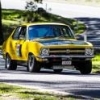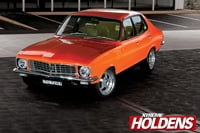it seems that it's not the " RPM at the engine it's the total RPM transfered through the 1 to 1 box " @ 6800 or 7200 which in essence means that the tailshaft is rotating the same as the engine.
For the hardy spicers chart the section size of the tailshaft VS the end RPM in top gear determines the diameter of the pipe needed.
It seems or what the bloke was saying was that the tailshaft will at that high rotation not remain straight and MAY distort.
he did say that once the tailshaft enters this state of vibration there is a chance that the shaft then starts to bend or deflect with the vibration and then once the distortion is in the shaft then they don't come straight again.
He recommended that i dont put in " hollow universals ( grease nipple types ) but solids, the car does not do enough driving to warrant greasable nipples for serviceability.
spoke to another racer and he just changes his unis each or every 12 meetings.
NOW as i said these cars have been turning thoes tailshafts to 7K for a long time, it would be sensible to change to a V8 yoke set up and a new tailshaft which is thicker but i just don't hear enough about a blown uni or tail shaft out in the field.
I suppose when you look at the gear box mount in these cars and have a look at the plate that holds the gear box in place it flexes under power and deceleration, it would also when under load and when changing gear introduce a vertical movement - i think that full noise down a straight 3 - 4 th may start or at least introduce the start of the problem of the wave through the tail shaft.
I have welded old push rods up all four sides of this gearbox plate ( this is the plate that bolts to both chassis rails and holds the box up ) to stiffen up the box and reduce flex in the plate.
Ps i really don't know as Im no expert in driveshafts - but i do know that mine was causing some serious vibration through the car and needed to be fixed before it caused damage.
a thicker tailshaft makes sense to me , bigger yokes, tube and uni's = less closer to the limit of old engineering.
Yes but it also needs the strength not to twist when a free reving thing at the front transmits a rotational force through it to a diff and set of wheels that dont want to or resist rotation.
peter may be able to shed some more light from his experiences
Edited by Agent 34, 18 February 2016 - 06:58 PM.




 View Garage
View Garage













